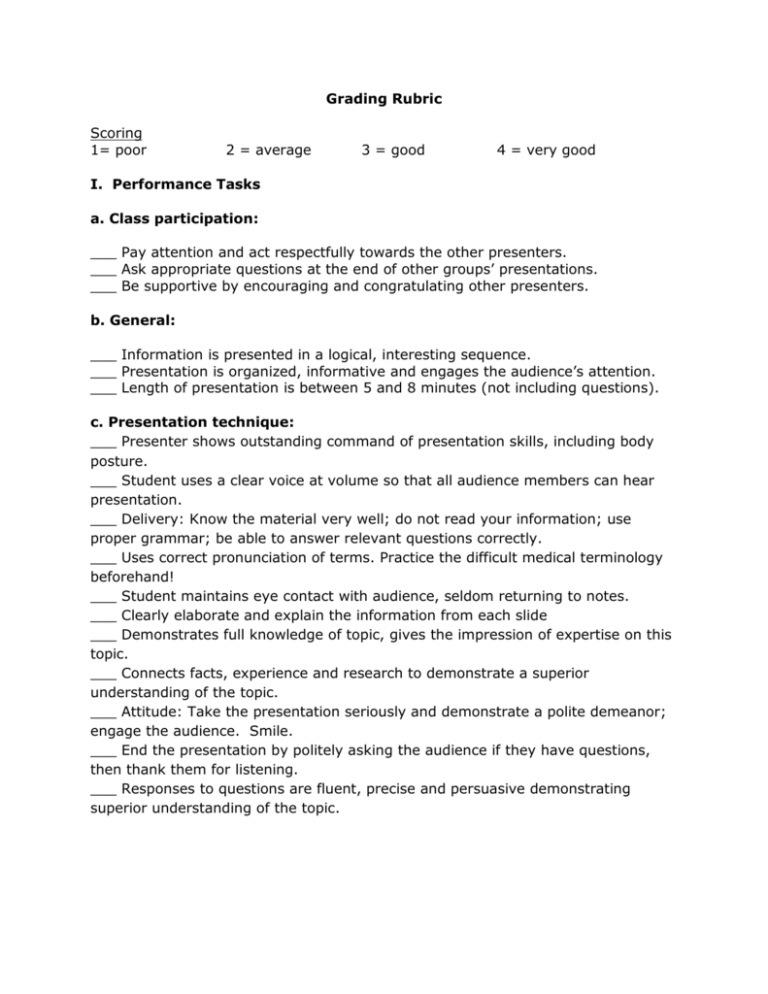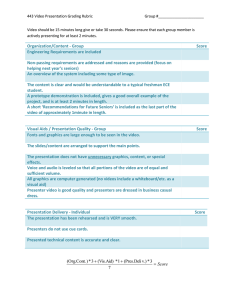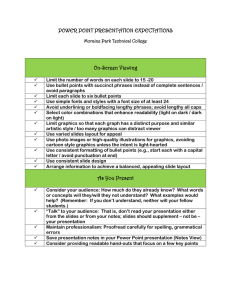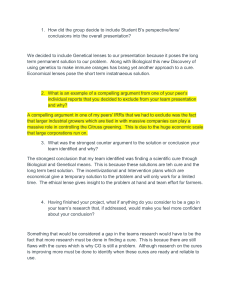Rubric
advertisement

Grading Rubric Scoring 1= poor 2 = average 3 = good 4 = very good I. Performance Tasks a. Class participation: ___ Pay attention and act respectfully towards the other presenters. ___ Ask appropriate questions at the end of other groups’ presentations. ___ Be supportive by encouraging and congratulating other presenters. b. General: ___ Information is presented in a logical, interesting sequence. ___ Presentation is organized, informative and engages the audience’s attention. ___ Length of presentation is between 5 and 8 minutes (not including questions). c. Presentation technique: ___ Presenter shows outstanding command of presentation skills, including body posture. ___ Student uses a clear voice at volume so that all audience members can hear presentation. ___ Delivery: Know the material very well; do not read your information; use proper grammar; be able to answer relevant questions correctly. ___ Uses correct pronunciation of terms. Practice the difficult medical terminology beforehand! ___ Student maintains eye contact with audience, seldom returning to notes. ___ Clearly elaborate and explain the information from each slide ___ Demonstrates full knowledge of topic, gives the impression of expertise on this topic. ___ Connects facts, experience and research to demonstrate a superior understanding of the topic. ___ Attitude: Take the presentation seriously and demonstrate a polite demeanor; engage the audience. Smile. ___ End the presentation by politely asking the audience if they have questions, then thank them for listening. ___ Responses to questions are fluent, precise and persuasive demonstrating superior understanding of the topic. II. Use of Technology: Overall Slide Elements: ___ All slides must enhance the audience’s understanding of your topic. ___ Presentation must be a minimum of five slides in length; plan for about 1 minute spent per slide. ___ Keep text succinct, limit your info to short bullet points; we don’t want to have to read every detail from the slide, we’d rather hear YOU elaborate! ___ All pages must be easy to read; large, neat, colorful, titled, and labeled ___ Text: Make all text large and contrast well with the background ___ Graphics: have an imported picture/graphic relevant to each slide ___ All graphics should be titled, labeled, or explained. ___ Graphics explain and reinforce screen text and presentation. ___ Presentation has no misspellings or grammatical errors. III. Content: Title Slide: ___ Name(s) of the disease (some have more than one name) ___ Name, date, and period ___ A relevant graphic Introduction. Introduce your disease in bullet form, discussing: ___ What is the disease? ___ Briefly describe how it affects its victims. ___ Cite statistics about the frequency of the occurrence in the population. What are the demographics of the disease? Is the incidence higher in a particular population? ___ Any relevant historical facts? Who discovered it? Named it? Symptoms of the Disease (Put information in bullets): ___ Symptoms of the disease. You must EXPLAIN them, not just list them. Be prepared to describe/explain symptoms during your oral presentation. How it affects its victims (more detail than in the introduction). Cause(s) of the disease: ___ Explain the genetic mode of transmission (e.g. trisomy, monosomy, autosomal recessive or dominant, sex-linked, multiple genes, etc.) ___ Give examples of how the gene would be passed on in families. Can it be due to a spontaneous mutation? ___ If the gene has been mapped, on what chromosome and locus is it found? Diagnosis: ___ Can the disease be predicted prenatally? ___ What tests are available? Severity of the disease: ___ How debilitating is it? ___ Is it lethal? Does it affect longevity? Average life expectancy? ___ What is the quality of life of an affected individual? ___ Does it affect life expectancy? Cures/Treatments: ___ What are the chances for a cure? Are therapies and cures available now? ___ Is there a promise of therapy or a cure in the future? ___ Can quality of life be improved? ___ What did you take away from your research into this topic, and what affect did this report have on your understanding of and attitude towards people with genetic diseases? Last Page = Bibliography: ___ List all of your resources Optional Information in the slide show might cover: the discovery of the disorder, how it was named, a timeline, information on gene therapy, or any other related topics. When was the disease first discovered and by whom? Is there anyone famous who has had the disease? Are there support groups or organizations for this disease? * YOU MUST PROVIDE A PRINTED COPY OF YOUR SLIDES FOR YOUR INSTRUCTOR (HANDOUT FORMAT, 3 TO 6 SLIDES PER PAGE)











